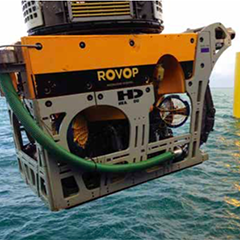Moray Melhuish, director of Rovop, talks to PES about the importance of planning ahead for all eventualities with Rovop’s Integrated Management System…..
PES: Welcome back to PES Wind. Would you like to introduce your company and explain a little about how you serve the wind industry?
Moray Melhuish: ROVOP is an independent ROV (remotely operated underwater vehicle) service provider. The founding purpose of the company was to bring the best possible ROV services, with the best technology and people, to the offshore wind sector. Although we have since diversified into the oil and gas industry we continue to work extensively throughout the European wind sector. This includes the support of UXO (unexploded ordnance) and boulder surveys and removals, foundation installation, inter-array and cable installation, as-built survey and inspection, maintenance and repair for existing wind farms.
PES: We note that you have recently announced a new collaboration with WFS Technologies which can reduce operating costs significantly. Are you able to expand on this for us a little?
MM: Shallow seas and powerful currents can impose considerable stresses on the foundation structures supporting offshore wind turbines and platforms. As a result, it is vitally important to monitor the behavior of structures, to ensure their continued integrity, but also to feed data in to the design of the next generation of structures required for the larger turbines we see coming to the market.
Also, all structures subsea are subject to some sort of corrosion. Cathodic protection can help safeguard against this, but it is vital to monitor the intensity of any ionic imbalance.
Fatigue and corrosion are normally monitored by a variety of independent measurement devices located at strategic points across the system. If these sensors have not been built into the structures, retro-fitting them can be expensive if cables have to be run. The development of wireless ‘Seatooth’ technology by WFS, deployed using ROVOP’s light work class ROV systems, enables these sensors to be efficiently and cost effectively deployed and wirelessly transmit readings on demand to one of our ROV’s as it passes.
This technology has the ability to enable better future decision making, but also to reduce operational costs. Rather than rely on a single point of data once a year, continual measurements can be taken to allow any deterioration to be trended. This means maintenance campaigns can be optimally timed and areas of concern identified and focused on in advance. Likewise, areas of no concern can be left alone, avoiding unnecessary expenditure and minimizing maintenance cost.























